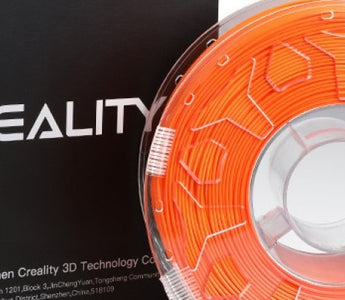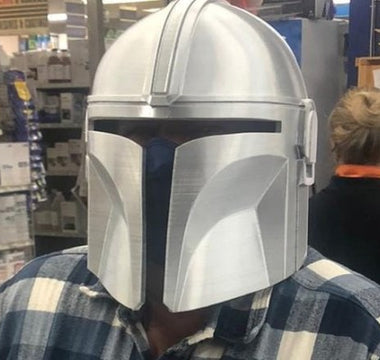Choosing the right filament can be a challenge when you have just gotten your first 3D printer. There are so many types and qualities available to us in the market it gets very confusing! We will be covering common uses, as well as some recommended applications for makers and cosplayers. Today we will go over some of the basics to get you started printing with the right filament for your task. If you would like an excellent spreadsheet please refer to this Simplify3D page.
You will almost always be using 1.75mm filament with nearly all modern printers. Filaments in sizes like 3mm have nearly been phased out for your average consumer. As always be sure to check what size your printer specifies to use before a purchase.
To begin we will be going over some of the properties of a few different types of filament available. Firstly we will have the 3 most common filaments used; PLA, ABS, and PETG. Secondly the more uncommon filaments include but are not limited to; TPU, HIPS, PVA, wood, and metal.
PLA or Polylactic Acid
PLA is the most common, and the most affordable filament on the market for nearly every task. PLA comes in a wide array of different colours, metallics, and even composite filaments. This is the ideal filament to choose if you are a maker or hobbyist just getting started.
You can purchase PLA filament online from us at: BuyIndustrial.ca
PROS
- Medium strength
- Medium durability
- Cost effective
- Many colours available
- Widely available
- Bio-degradable
- Easy to print
- Easily glue-able with most glues
- Food-grade options available, but not recommended
- Minor shrinkage after cooling
CONS
- Can be fragile and break easily if dropped
- Melts at low temperatures
- Zero flexibility
- Brittle
ABS or Acrylonitrile Butadiene Styrene
ABS is commonly used as part components when durability is required. You can find ABS used in many automotive parts not just as a filament. The most important thing to know about ABS is a fume hood/enclosure is required.
PROS
- High strength
- High durability
- Impact resistant
- Plenty of colour to choose from
CONS
- Requires ventilation
- Requires an enclosure
- Moderate difficulty to print
- Sensitive to heat fluctuations
- Shrinkage will occur after cooling
- Heatbed required
PETG or Polyethylene Terephthalate Glycol
PETG is a great filament to choose if you plan on making parts where high strength is needed. PETG has many similar properties to ABS, but without many of the drawbacks.You can purchase PETG filament online from us at: BuyIndustrial.ca
PROS
- Shiny finished product
- Semi-rigid
- Waterproof
- Nearly odourless
- Minimal shrinkage once cooled
CONS
- More expensive material
- Soft and not suitable for high wear parts
- Stringing is very common
- Moderate difficulty to print
- Not to be used with glass beds
Now we're getting into the less common, and more specialized filament. Some of these are fun for crafting, and some are great for engineering or even soluble supports.
TPU or Thermoplastic Polyurethane
TPU is quite the interesting material. You will see makers and costumers use it in ways you may have never thought of. TPU can be a very flexible filament, but it can also be very stiff. This is the ideal filament to use if you need a material to be flexible, impact resistant, and elastic.Some common applications include instrument panels and sensors, levers, sporting goods, and flexible cosplay parts. I good application of TPU in a cosplay for instance would be any sci-fi suit requiring a seal. You may have seen cosplayers use this as a neck seal on Master Chief costumes.
You can purchase PETG filament online from us at: BuyIndustrial.ca
PROS
- Many hardness selections
- Excellent impact resistance
- High durability and strength
- Medium chemical resistance
CONS
- Higher difficulty printing
- Print speed is much slower
- High chance of blobs and zits without proper retraction
HIPS or High Impact Polystyrene
HIPS is most commonly utilized as a soluble support for ABS printing. HIPS is soluble in d-Limonene. HIPS has many of the same printing properties and requirements as ABS. Therefore a perfect support material to be paired with an ABS filament. It is also more dimensionally stable with less shrinkage than ABS. HIPS does require the use of an enclosure and ventilation just like ABS.
PROS
- Excellent support material for ABS
- Soluble in d-Limonene
- Lightweight
- Inexpensive
CONS
- Requires ventilation
- High printing temperatures
- Heatbed required
- Requires an enclosure
PVA or Polyvinyl Alcohol
PVA is an excellent addition to any multi-material printer. PVA is water soluble making it bio-degradable. PVA is best used on complex prints where support material is encased. PVA being water soluble means it is moisture sensitive like PLA. Keeping it in a sealed container with desiccant packets is recommended for long term storage.
PROS
- Bio-degradable and water soluble
- Soft material
- Easy to print
CONS
- Moisture sensitive
- Expensive
- Can clog nozzles if left idling with a heated hotend
- Airtight storage required
- Low strength
Wood Composite PLA
Wood filaments aren't typically used in common applications. Most commonly these are used when creating decorative pieces, artworks, and even some cosplay props where strength is needed. Wood filament is typically a composite of PLA combined with a percentage of filler. Some filaments will be with consist of a plastic besides PLA, so always be sure to check the manufactures specifications. Wood filament will consist of roughly 30% wood derived material. This can include sawdust and wood flours, cork, or other wood based powders. This is a relatively inexpensive filament as it is made from renewable resources. Being both PLA and wood derivative makes this filament more environmentally friendly than most.
PROS
- Medium high strength
- Wood texture
- No unpleasant odours
- Uses typical nozzles
- May require a larger nozzle
- Higher chance of stinging
- Can clog with small diameter nozzles
Metal Composite PLA
Metal filaments again aren't typically used in common applications. Metal filament is not to be confused with the aesthetically similar metallic pigmented PLA. Most commonly metal filaments are used when creating decorative pieces and jewellery where a cast metal appearance is desired. Metal filament like its wood counterpart will contain different percentages of very fine metal powder such as Copper, Bronze, Brass, and Stainless Steel. Metal filaments will have some weight to them dependant upon the chosen type. This could be very beneficial for some uses like statues or paper weights.
PROS
- Heavy
- Rigid
- Similar appearance to metals
CONS
- Expensive
- A high wear nozzle is required
- Poor bridging and overhangs
- Clogs happen over time
- Printed objects are brittle
Now that you know the basics of the most common and some uncommon filaments we hope you feel confident selecting the right one for your task! If you may have any questions on a certain filament or 3D printer questions don't hesitate to leave a comment, or contact us online, or by phone. Stay tuned for more posts relating to FDM printing and SLA printing.


